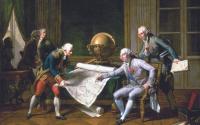The La Pérouse Story
24 April 24
Famous Mason by RW Bro Ted Simmons OAM
The Sydney eastern suburb of La Perouse is an attraction for tourists and locals as part of the network of beaches and various local interesting sites.
But few people are aware that the suburb was named after a famous French explorer and naval officer, who was among the first to sail to the land called Terra Australis and explore the southern waters of planet Earth.
Jean-Francois de Galaup, Comte (Count) de Lapérouse (variant spelling La Pérouse) was born into nobility on 22 August 1741 at the Castle La Guo near Albi in Southern France – about 60km north-east of Toulouse. He soon became simply referred to by his title of ‘La Pérouse’.
After leaving local school at age 15, he reported to the naval training establishment at the port of Brest. In 1759 he was wounded at the Battle of Quiberon Bay and taken prisoner.
After two years he was repatriated from England and returned to naval duties, where he worked on his ability as a seaman and navigator. During a later visit to India, he met and married Elenore Brouden in June 1783.

Louis XVI giving his instructions to La Pérouse by Nicolas-André Monsiau. La Pérouse is pictured on the left.
Promoted to Captain in 1780, he took part in the American war with significant success. This led to his selection in 1783 when the French government decided to send an expedition to the Pacific to complete the unfinished work of Captain Cook, exploring the possibility of a north-west passage in the Bering Sea.
La Pérouse was appointed captain of a two vessel fleet comprising La Boussole and L’Astrolabe. They left Brest in August 1785 sailing to Brazil, Chile, the Sandwich Islands (now Hawaii), Alaska and California before sailing across the Pacific in the direction of what was known as New Holland.

An illustration imagining the
fate of La Astrolabe and La
Boussole in the Solomon
Islands by Louis Le Breton
In December at the Samoan island of Tutiula, some of the residents suddenly attacked a party from one of the ships, killing 12 men including the second in command to La Pérouse.
He did not take any reprisal action and sailed to Norfolk Island and was sighted off the coast of NSW on 24 January 1788 but bad weather prevented the French ships from entering Botany Bay.
The arrival of the two ships caused some concern amongst members of the British First Fleet who were unsure from which country they had sailed. Captain Arthur Phillip decided they were French on a voyage of discovery.
In courtesy calls between the two groups, the French explained they were seeking to replenish supplies and in doing so erected a small timber stockade on the northern shore, just inside the head of Botany Bay. In their talks, La Pérouse said that he expected to be back in France within 15 months and that he needed three years' supply of provisions.

Map of La Pérouse’s ill-fated scientific voyage, showing a
selection of stops.
There were meetings between staff members of (by then) Governor Phillip and the French vessels but there was not any record of a meeting between La Pérouse and Governor Phillip.
On 10 March 1788, it was reported that guns were used against the local Aboriginals who were believed to be creating a threat. La Pérouse recorded that the country and its peoples (aborigines) were very inferior to others that he had met.
On the same day, La Pérouse sailed from Botany Bay and was never heard from again.

A woodcut illustrating La Pérouse’s visit to Rapa Nui in 1786, interacting with the Rapa Nui people and examining the Moai(statues).
Relations between France and Britain deteriorated and unfounded rumours spread in France blaming the British for the tragedy which had occurred in the vicinity of the new Australian colony.
However while visiting what is now the Solomon Islands in 1826, Irish captain Peter Dillon bought several swords which locals believed had belonged to La Pérouse. The locals also said the swords had come from a nearby island where two large ships had broken up.
It was not until 1964 that the wreck of La Boussole was finally discovered on the island reefs and the fate of La Pérouse and his crew was known.
Bro Jean-Francois La Pérouse was made a mason at Brest in France on 26 July 1765, passed to the Second Degree on 26 August 1765 and raised to a Master Mason on 12 April 1766. He was also admitted to the rank of Perfect Master Scottish Elect of what is now known as the Ancient and Accepted Scottish Rite.


